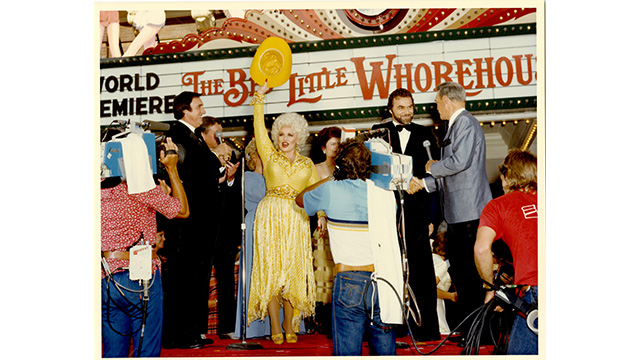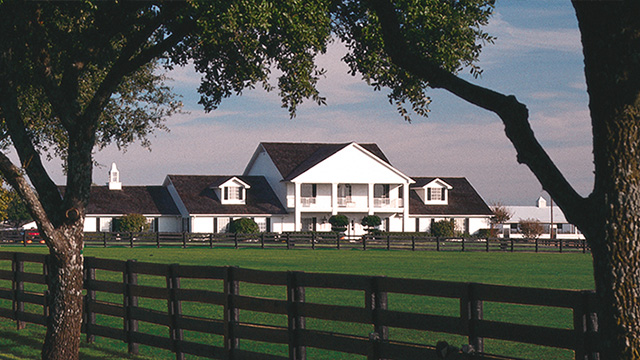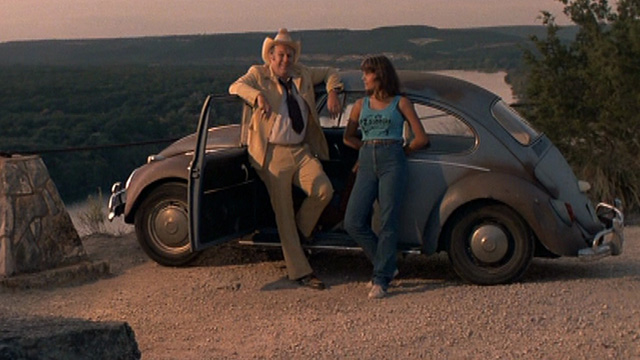1980s: Texas Identity

The 1980s were a decade of transition and development for Texas onscreen. While Americans reflected upon their national identity, Texans did much the same with their state’s identity. Urbanization, which had already begun to emerge by the start of the decade, would reveal itself as one of the great driving forces behind much of the development to come over the course of the 80s. Developments that built upon the framework laid by the pioneers of the preceding decade and would lead inevitably into what we now think of as modern Texas, or more simply, Texas. One film released in the summer of 1980 would wrestle with the elemental themes that would define the state for most of the decade and beyond. That film was James Bridges’ Urban Cowboy.
Filmed on location in Houston, Urban Cowboy is the tale of Bud (John Travolta) and Sissy (Debra Winger), young Texans who quickly fall in love – and marry even faster. Beneath that, however, is a story of shifting social classes, the intersecting worlds of old and new Texas and the push-pull tension that developed as metropolitan areas like Houston began to encroach more heavily upon traditional, rural Texas. Vincent Canby said in his review of the film: “To millions of Americans, places like Gilley’s, even those without mechanical bulls, are the last outposts of the American frontier.” From early on it is obvious that this is how Bud views the world – the film opens with his driving away from the countryside, off the farm and into Houston. He spends just about every night at Gilley’s playacting the role of a cowboy, even though he spends his days working in a petrochemical plant, a tangible symbol of industrial Texas shifting away from the wide open plains. Gone is the future Bud must have always imagined for himself as he falls into the city; into “Houston proper”, as one character refers to the world within the highway boundary known as the 610-loop.
Urban Cowboy would go on to gross just under $47 million at the box office, making it the 13th most financially successful film of 1980 and the decade’s first big hit to emerge from the Lone Star State. It would not, however, be the last. Just two years later audiences would take a trip down to Gilbert, Texas (read – Pflugerville, Texas) to visit The Best Little Whorehouse in Texas.

The world premiere of The Best Little Whorehouse in Texas at the Paramount Theatre in Austin in 1982.
(Photo Credit: 1983/011-09, Courtesy of Texas State Library and Archives Commission)
An adaptation of a Broadway play, The Best Little Whorehouse in Texas was released in the summer of 1982 and immediately enraptured audiences with its overtly theatrical representation of a small Texas town embroiled in a scandal brought upon them by the powers that be in far-off Houston and Austin (with the help of one particularly relentless New Jerseyite). The film was shot primarily in-state, making extensive use of locations in Pflugerville, as well as Hallettsville, Victoria, College Station and Austin. Perhaps as a result of their use here, many of the film’s selected locations are still frequently requested by productions to this day. In what is arguably one of the most memorable musical numbers in the film, the Governor (played by Charles Durning in an Academy Award-nominated performance) dances his way throughout the capitol building. The film would top Urban Cowboy’s box office achievement, ending 1982 as the 10th highest grossing film of the year.
In 1983, one of the Lone Star State’s most accomplished native sons, Larry McMurtry, returned to theaters with what would prove to be the most enduringly beloved big-screen adaptation of any of his novels. Terms of Endearment, starring Shirley MacLaine, Jack Nicholson and Urban Cowboy’s Debra Winger is a story of mothers and daughters, romantic love, and how both change over time. The city of Houston, and its suburbs, had seldom been rendered so lovingly onscreen.
The film is simple on its surface and exhilaratingly complex just beneath. In that way it reflects so many of the films produced in Texas over the course of the 1980s. Perhaps this, whether consciously or unconsciously, is a response to the more anarchic filmmaking exhibited in the 1970s. Whereas before, viewers were treated to cinematic mythologizing – grand tales of cops and robbers, villains too hideous to be believed – films like Terms of Endearment showcase an altogether new side of Texas-set storytelling, one more true to the lives of the suburban moviegoers. In films like these, the stakes are more often internal and explore whether our hero will be able to corral their ego in time to hold on to the ones they love. Will they finally admit that they can be hard-headed and prideful (as so many of the great characters of this era were) before it’s too late? Undoubtedly, it is this reflection of a world audiences recognized as true to their own which drove the film to garner the second highest box office total of 1983. Grossing a whopping $108,000,000, it was beaten only by a little-known film you’ve probably heard of: Star Wars: Episode VI – Return of the Jedi.
Though the general focus may have shifted slightly towards a more personal, introspective mode of storytelling, that was not the only type of film to come out of Texas during this decade. Just the following year a pair of unknown filmmakers would release their debut film, eventually launching them into the heights of American cinema. Shot over eight weeks in Hutto, Austin and the surrounding areas, Blood Simple would pull that focus away from the suburbs and the big cities and direct it once more to the seedier underbellies that earlier films like Sam Peckinpah’s The Getaway reveled in.
Still from Blood Simple (1984) / © River Road Productions
Blood Simple is an indie film to its core (before there even was such a term), technically classified as a thriller but quite easily conflated with the horror genre. In it, the Coen brothers use the trappings of genre filmmaking to deal with those same themes which weave their way throughout the decade – anxiety of a changing world, mistrust of those who ought to be trusted most of all, the sense that one is trapped, be it by circumstance, location or, in this particular instance, a murderous husband and his psychotic hired gun. When observed from the right angles, Frances McDormand’s adulterous Abby is not so far removed from Jeff Daniel’s philandering Flap Horton in Terms of Endearment; from those same angles, Terms of Endearment’s Emma Greenway-Horton is not so different from Blood Simple’s Julien Marty (the aforementioned murderous husband), each grasping for some way to wrest authority over lives which seem to have slipped from their control.
For all its twisted charm, Blood Simple would not crack the top 100 highest grossing movies of 1984. Nor would Paris, Texas, another indie that filmed in locations that stretch across the entire state from El Paso to Houston, Port Arthur and even Nordheim (though ironically enough, never in the actual Paris, Texas). Robert Benton’s Depression-era drama Places in the Heart would take that honor however – set and shot in Waxahachie, the film stars Sally Field and Danny Glover as a local sheriff’s widow and the itinerate drifter who helps to maintain the family farm in the wake of her husband’s unexpected demise. Marketed as a film about growing up American, it can perhaps more accurately be described through the lens that critic Pauline Kael used to discuss it, as “about growing up at American movies” and, by extension, growing up at Texan movies. Though perhaps a bit too soft around the edges to serve as a truly unclouded window into Texas’ past, the film is an engaging look at the Texas of the 1930s, interested in dealing directly with the stories we as Texans tell ourselves about ourselves; to watch Places in the Heart is to engage with the myth of what Texas once was and all the good and ill that are part and parcel of that oft romanticized past. As a result, critics and audiences overwhelmingly responded favorably to the film, setting it up to close out the year as the 24th highest grossing film of 1984.

Original film from behind-the-scenes of True Stories (1985). View more from TFC archives.
The middle years of the decade would see an impressive number of original films shot in Texas and released to the public, including David Byrne’s wholly idiosyncratic True Stories, as well as Bill Wittliff and Willie Nelson’s big screen adaptation of Nelson’s wildly successful album Red Headed Stranger (good luck trying to watch it today – the film never made the leap from VHS to DVD). But it wouldn’t be until the summer of 1987 before the Lone Star State produced another undeniable hit.
Released in the dog days of summer, Robocop plays directly upon the anxieties inherent to so many of the cyberpunk films and video games released during this decade, in telling the story of a decent cop resurrected from the grave to serve the wishes of a dystopian megacorporation. Though the film is set in a dilapidated future Detroit, in reality what viewers were treated to were glimpses of Dallas and Irving, Texas, two cities replete with futuristic architecture and at the time two of the most prosperous hubs of commercial production in the state. An interesting and oft forgotten truth about the state of Texas media production in the 1980s: while all of the productions referenced here undoubtedly took the main stage in terms of the attention they pulled towards The Third Coast, throughout the decade another less critically regarded type of production consistently helped keep the gears of industry turning in Texas: made-for-TV movies.
Typically budgeted somewhere between $1.5-$3 million, TV movies were the bread by which Texas crew members sustained themselves in the 1980s, most notably during those periods in between some of the aforementioned feature film productions. Recall the birth in the 1970s of Austin City Limits, the foundation of a dedicated crew base in Texas and with it the foundation of a world equidistant from both New York and Los Angeles wherein film production was more than viable simply because the people who would actually help to make the movies could be sourced locally. It was in this world and because of this crew base that Texas saw an influx of TV movies over the course of the 80s, films like Skyward, Dream Date, Skyward Christmas and more. These productions were enticed to the state by the already deep pool of professional crew from which to draw upon; in turn, those same productions provided valuable wages, experience and opportunities that expanded and strengthened the skills of that crew base. It was this perpetual motion machine which helped to prepare those living and working in Texas for what would be the most iconic television productions to come out of the state in that decade – the eight-hour western epic, Lonesome Dove and the prime-time soap opera Dallas.
Based on the Pulitzer Prize-winning novel by - who else? - Larry McMurtry and with a screenplay by Bill Wittliff, Lonesome Dove is the story of the Hat Creek Cattle Company and their efforts to drive a herd of cattle from Texas all the way to Montana. Starring Tommy Lee Jones and Robert Duvall (and many more), the film is one of the lone breakout productions from this period which is uninterested with the intersected trails of new and old Texas. Instead, it seeks to deal directly with the myth of Texas’ past. Filmed primarily on the Moody Ranch near Del Rio, the miniseries spotlights some of the most iconic countryside in the state, utilizing it to full effect not just as a backdrop for the Dickensian tale of McMurtry’s original text, but as a window into a world national audiences might have erroneously believed to have receded into the past along with larger-than-life figures such as Texas Rangers Gus McRae and Woodrow F. Call.
Lonesome Dove would be watched in almost 26 million homes when it aired in February 1989, breathing new life into the western genre, one that would experience an unexpected resurgence of popularity in the decade to come.

Southfork Ranch is home to the iconic TV series Dallas (1978-91). Visit the location.
If Lonesome Dove revitalized the western genre then Dallas glamourized ranching life, propelling it to soapy excess and making it mainstream. A prime-time soap opera writ large, Dallas chronicled the lives of the Ewing dynasty and all the twists, turns and drama therein. More than that though, the series, which ran throughout the whole of the decade, functioned as one of the most popular displays of the shifting, amorphous Texan identity in the public eye. With their family’s fortune tied up in both cattle ranching and Ewing Oil, Dallas’ titular family straddled the line between Texas’ past and its future, between the rural and the industrial. In this way, the show helped to shape how Texans would be perceived by the world beyond the state’s borders. Viewers around the globe tuned in every Friday night to watch J.R., Bobby, Sue Ellen and the rest of the Ewings play out scenes from a heightened Texas that was no less a fantasy than the one Urban Cowboy’s Bud searched for every night at Gilley’s, against a backdrop that reflected the indeterminate, entangled threads of Texan’s real-world identity.
Though the series premiered in 1978, its popularity would prove meteoric in the 1980s, taking one of the top two slots in Nielson rankings five years in a row. At 357 episodes, it still stands as one of the longest-running full-hour prime-time dramas in American television history, running from 1978 all the way through 1991 (it would also be reimagined in 2012 and run for an additional three seasons). Thus Dallas, like Urban Cowboy before it, would serve as something of a bridge between eras, a link between two worlds with different concerns yet inextricably tied to one another. There is a clear progression which would come to the forefront in the decade to follow – a foundation laid by the pioneers of the 1970s and developed into a self-sustaining industry in the contradictory yet prosperous 1980s that would finally come to fully-formed providence in the 1990s. Just around the corner was Richard Linklater's Slacker, signaling the birth of a new wave of American filmmakers working alongside, and also within, the well-oiled machine of major motion pictures in the Lone Star State.
Continue: Spotlight on Texas in the 1990s
Written and edited by Steven McCaig, Kim LeBlanc and Tara Khanna. Thank you to our guest editor, Carol Pirie, who served the Texas Film Commission from 1987–2011, retiring as Deputy Director.

